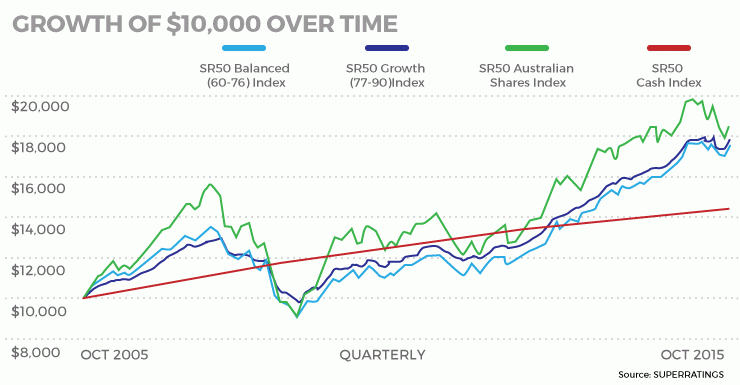We present the best performing superannuation option


Superannuation investors game enough to put 100 per cent of their funds into Australian shares have enjoyed the highest average annual returns over the past decade.
Data compiled specifically for The New Daily by independent superannuation research firm SuperRatings shows the average annual return from Australian shares since October 2005 has been 6.4 per cent.
That compares very favourably with the lowest returning option – cash – which earned 3.9 per cent.
• How a glass of wine can save you tens of thousands of dollars
• Senators ditch superannuation reforms
• A new way to spend your kids’ inheritance
According to SuperRatings, just 3.5 per cent of fund members currently invest their entire super in Australian shares, while 4.4 per cent have all their funds in cash.
The standard default ‘balanced’ investment option, which spreads holdings across multiple asset classes, remains the most popular superannuation investment allocation, with 61.1 per cent of all super fund holdings.
The next highest allocation (13 per cent) is to ‘growth’ assets, which generally cover a mix of shares, alternative investments and property.
Property and international shares each account for less than 1 per cent of investment allocations.
Balanced fund options have achieved an average annual return of 6.2 per cent over the past decade, while those who had selected a growth assets-only option have achieved a lower average return of 6.0 per cent per annum. This proves that higher-risk investments do not necessarily translate into higher returns.
Splitting funds between different investment allocations also does not always equal better overall results.
What it means for your balance
In dollar terms, a $10,000 investment into Australian shares in October 2005 would now be worth $18,632, while the same amount invested into a Balanced option would be worth $17,839. Funds invested into cash only would be worth $14,501.
On a superannuation balance of $100,000 back in 2005, that means there is a whopping $40,000 difference in average returns for those who invested only in Australian shares versus those who were solely in cash.
A different strategy
SuperRatings general manager research, Kirby Rappell, says one trend in recent years has been an increase in the proportion of funds offering differing strategies based on age.
“This may be, for example, a growth option (77-90 per cent growth assets) until age 40, then a Balanced option till age 65 (60-76 per cent growth assets), then a capital stable option (20-40 per cent growth assets) from age 65,” Mr Rappell said.
“This reflects the focus on de-risking people appropriately as their account balance grows, while also ensuring that they do not give up too much exposure to growth assets. It is fair to say this remains a work in progress across the industry, with varying beliefs evident as to the best approach across different providers.”










